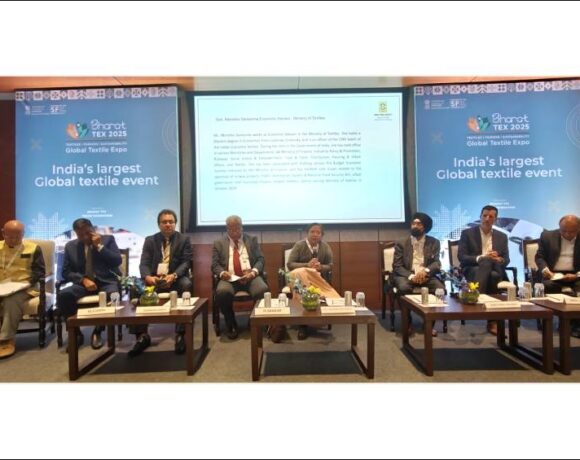ITMA 2023: Reducing & Recycling Textile Waste for Sustainability

Reducing textile consumption, recycling textile waste, composting and donating textiles to charity or textile recycling programmes can help the industry move towards sustainability, says Murugan Santhanam
When I entered the house of my friend, I saw my friend sitting in a cramped space in the room. The room was filled with closets and we had to squeeze onto a sofa that was wedged between two closets.
“Why so many closets?” I asked.
He looked at me innocently as if he were helpless.
“Every year, I have to add one more closet to accommodate the dresses that my wife and daughter buy. It seems like a never-ending cycle. I think I may need to build a new house sooner rather than later,” he said worriedly.
For a moment, I could see the same situation in my house flashing in my mind.
“Aren’t we Indians who don’t donate old clothes to others or recycle them if fashion changes?” I asked myself.
Interestingly, I understand that the theme of ITMA 2023, held recently in Milan, was sustainability, circularity and digitalization.
The event featured a number of exhibits and presentations focused on these topics, and many of the exhibitors were showcasing new technologies and products that could help the textile industry become more sustainable.
The sustainability methods included a new type of yarn made from recycled plastic bottles, a water-saving dyeing process and a machine that can recycle textiles into new materials.
These events brought together industry leaders, academics and policymakers to discuss the challenges and opportunities facing the textile industry as it moves towards a more sustainable future.
Overall, I am quite convinced that ITMA 2023 was a clear indication that the textile industry is taking sustainability seriously. However, there have not been much real changes in the textile fields in terms of sustainability and circularity as has been done in digitalisation. With many machines incorporating artificial intelligence at faster pace, sustainability and circularity in textiles still have a long way to go before they reach every individual person/manufacturer, especially in India.
If you watch videos of interviews with many manufacturers who displayed their machinery at the ITMA Exhibition (and even some mill people), you will hear them all talking about sustainability and circularity. One way is surely going for modernisation with latest machineries as displayed in ITMA 2023. But, I feel, it can be done by select few. With the textile industry in a slump for several months all over the world, who is willing to invest in new machinery to achieve these goals? This is a daunting question that has been on my mind lately.
It appears more so daunting especially after seeing the data from Central Pollution Control Board (CPCB). According to CPCB, there were 2,032 operational landfills in India as of March 2022. The total area of these landfills was 15,000 hectares. The CPCB also estimates that India generates 250,000 tonnes of municipal solid waste (MSW) per day. Of this, only 60% is collected and only 10% is treated. The remaining 90% is dumped in landfills.
The report further states that textile materials account for 12% of the municipal solid waste (MSW) generated in India. This means that approximately 30,000 tonnes of textile materials are sent to landfills every day. (If we collect all the unused clothes stashed in the closets in every household, the figure will be very high!).
The textile industry is a major contributor to waste generation in India. The production of textiles requires a lot of water, energy and chemicals. This leads to the generation of a large amount of waste, including wastewater, solid waste and hazardous waste.
Textile waste can have a number of negative effects on the environment. When textile waste is sent to landfills, it can release methane, a greenhouse gas that is 25 times more potent than carbon dioxide. Textile waste can also pollute water bodies and soil.
It is certain that our textile industry is moving towards sustainability and circularity, but investing in such machineries will take a long time.
What we need to do is to speed up the measures that are easy to implement and also require less or no investment.
Some of the suggestions that can be implemented to reduce the amount of textile waste generated in India include:
- Reducing consumption: One of the best ways to reduce textile waste is to reduce consumption. This can be done by buying less clothing, buying second-hand clothing and repairing or upcycling old clothing.
- Recycling: Textiles can be recycled into new products, such as insulation, carpets, and clothing.
- Composting: Textiles can be composted into a nutrient-rich soil amendment.
- Donating: Textiles can be donated to charity or to textile recycling programmes.
By taking these steps, we can help reduce the amount of textile waste generated in India and protect the environment.
However, will the implementation of the above suggestions affect the production volume and profitability of textile industry as a whole?
I reckon that if the textile industry changes some of its business model to include the above business propositions, we may speed up achieving zero landfills of textile materials without the industry getting adversely affected.
We request our readers to convey their opinions and suggestions which can be discussed in the articles in the forthcoming issues.
(Murugan Santhanam is the Managing Director of Texdoc Online Solution Pvt. Ltd.)














